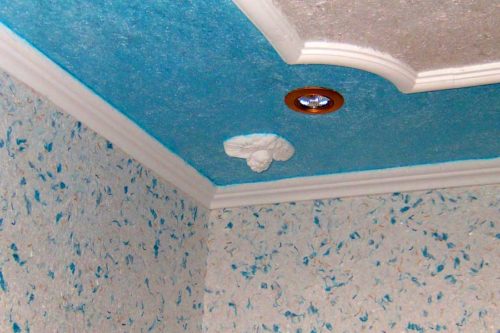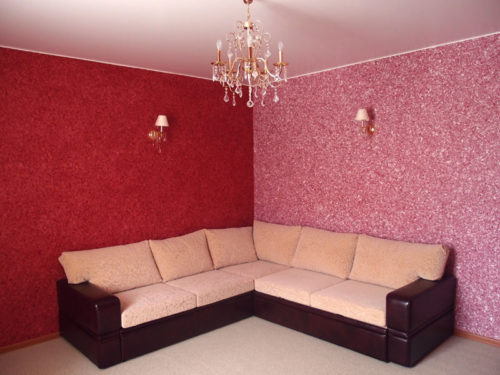One of the unique decorative coatings of modernity is liquid wallpaper. This innovative material that has enlightened the best properties of finishing products, serves to decorate walls and ceilings. Our article outlines instructions for applying liquid wallpaper.
Content
Characteristics of liquid wallpaper
This finishing material represents something average between ordinary paper wallpaper and decorative plastering composition. The name of liquid wallpaper is not entirely true. Material for sale in the form of a dry mixture. The work maker is obtained by mixing a dry mixture with water.
The main component of the dry mix - natural fiber (silk, cellulose, cotton). Fiber is crushed to the necessary sizes with the addition of decorative additives, dyes and adhesive composition (usually this is CMC).
Features of liquid wallpapers are as follows. The technology of surface coating with liquid wallpaper is similar to applying decorative plaster. And the finish coating is no different from vinyl or paper wallpapers with the original texture. As decoration, we use sparkles, resin or wooden particles, elements of plastic.
The main characteristics of the finishing material:
- layer thickness - 1-3 mm / 1 m²;
- flow of liquid wallpaper - 1kg / 3-5 m²;
- density - 60-70 kg / m³;
- elasticity on the gap - 3-7 mm / 1 m².
The advantages of liquid wallpaper:
- absolute environmental friendliness (consist of natural components);
- resistance to ultraviolet (do not fade) and temperature fluctuations (you can finish the cold room);
- elasticity (the coating does not crack and is not deformed);
- minimal labor complexity;
- simplicity of applying material;
- excellent thermal insulation and sound insulation properties;
- the impossibility of the appearance of fungus and mold (due to the lack of greenhouse effect);
- excellent antistaticity;
- the ability to replace the damaged area;
- the lack of seams on the walls (the room acquires a more attractive appearance);
- long operational period (more than 10 years).
Disadvantages of liquid wallpaper:
- low moisture resistance;
- very strong pollution is almost impossible to wash;
- when replacing the damaged or dirty area, a dry mixture of the same company and colors will be required;
- limited range of colors;
- high cost of material;
- long dried period (up to 3 days).
Varieties of liquid wallpaper
There are the following types of liquid wallpaper:
- silk;
- pulp;
- cotton;
- combined.
Silk products - the most expensive material. But it is distinguished by maximum wear resistance, heat and sound insulation. Silk liquid wallpapers are characterized by a long operational period.
Material made of cellulose is cheaper. Compared to silk products, it has a less attractive appearance. It is recommended to use in rooms located on the north.
Liquid cotton wallpapers are hypoallergenic coating. Due to its high elasticity, all irregularities are filled and the surface without seams is formed. The only nuance - cotton wallpaper must be cleaned.
The combined version is a mixture of cellulose and silk liquid wallpaper. It is an economical option with affordable cost and average resistance to solar rays and mechanical loads.
When choosing a finishing material, you should give preference to known manufacturers who have proven themselves in the product market. Popular products include:
- Silk Plaster;
- Bayramix;
- Senideco;
- Cotex;
- Silkcoat.
Preparatory stage to apply liquid wallpaper
At this stage, all major irregularities and noticeable defects are eliminated. Small chips and cracks are not a significant problem.
An old coating (paint, wallpaper, lime, dropping plaster) is removed from the walls. The surface is cleared of dirt. In the presence of fungi or mold, they are written, and the area is processed by an antiseptic.
After preparing the base on the walls, primer is applied. It should not be diluted. The abundant will be a layer of primer, the better the adhesion of liquid wallpapers with the surface will be. As a result of the priming walls, the walls should turn out to be slightly rough and light without extraction spots, without recking the size of over 3 mm per 1 m length.
Also the walls should be relatively dry. The permissible moisture content of the surface is:
- for a wooden base - below 12%;
- for other types of walls - below 8%.
Making liquid wallpaper
When purchasing liquid wallpapers, it will be necessary to pay attention to the shelf life. It usually does not exceed 2 years.
In the manufacture of finishing material, you must adhere to the instruction that is attached to the product. In most cases, the manufacture of liquid wallpaper is as follows:
- in the plastic container, warm water is poured with a temperature of 35-40ºС;
- dry mixture is poured into water;
- the composition is thoroughly mixed with hands;
- liquid wallpapers are left for 6-12 hours;
- before use, the mixture is mixed again.
It should be noted that the package of a dry mix is \u200b\u200brecommended to use immediately. Only this is what the uniform distribution of components is achieved and one-photon texture of liquid wallpaper is obtained. The material of the material is carried out in such a way that it is enough for the whole wall. The residue is used for the next place.
Making liquid wallpapers at home
Those who have free time can make material independently:
- paper is cut into small pieces;
- it is poured with warm water (1 kg of paper for 2 kg of water);
- pieces of paper are stirred in water and left for 24 hours;
- all components (threads, wool, sequins) are crushed at the rate of 1 kg of paper 250 g of watts, 200 g of other products;
- a construction mixer paper with water is whipped to a homogeneous mass;
- a wool with the other components is added to the resulting composition;
- everything is mixed with their hands;
- pVA glue is added to the mixture (0.4 kg per 1 kg of paper);
- the composition is mixed again;
- it is added to it, which should evenly host all the mixture;
- ready wallpapers are stacked in a plastic bag, close tightly and left for 24 hours;
- a day later, a luggage glue based on CMC-based wallpaper adhesive (150-200 g / 1 kg of composition) is added to the mixture;
- the composition is thoroughly mixed.
Wall covering with liquid wallpaper
After cooking the working mixture it is applied to the walls. To do this, you will need such tools:
- putty knife;
- plastic or metal grater.
Of course, you can get a special grater-spatula, which is distinguished by the usual tool. This plastic tool for working with liquid wallpaper is used when applied to the walls of the drawings.
The decoration of walls with liquid wallpapers implies the implementation of such actions:
- the composition from the container is gained by a spatula;
- it is triturated over the surface with circular movements;
- the tool with a mixture is sent to the wall at an angle of 15º.
Work begins in a bright corner with a gradual transition to a dark part of the room. In the corners, the mixture is recomposed towards the corners. Excess wallpapers are removed from the surface only after their drying.
Mandatory controlled thickness of the finishing coating. It should be the same. To create a high-quality surface, use lateral lighting, thanks to which all defects are visible.
To eliminate any defect on a bit of dried wallpaper, use a spatula moistened in water. The tool is carried out by irregularities. But do not need to crush greatly. It is also forbidden to level the surface in the presence of highly wet wallpapers, since the finishing material will plunge behind the spatula.
If the process of applying liquid wallpaper continues the next day, the adjacent area with dried wallpaper is wetted with water.
In a children's room from liquid wallpapers, you can make a fragment from your favorite fairy tale or cartoon. To create an applique:
- a simple pencil on the wall is applied with a drawing;
- a mixture of 2 mm thick is applied to the drawing (it should be 1-2 mm due to the contours);
- with the help of a small rubber spatula, wallpapers coming out for the contour of the sketch are moving into the inner part of the contour;
- drying pattern occurs (it is possible to reduce the time of the process using a conventional hair dryer);
- the coating of the adjacent area is carried out with an indent of 1-2 mm (it is so prevented by "hitting" a new layer on the created pattern);
- after drying, the created fragments can be highlighted with markers and embellish with sequins or beads.
In the course of work, it should be noted that when using wallpaper with a kel, the bottom layer can be painted in the case of the upper part of the contour of the pattern.
























